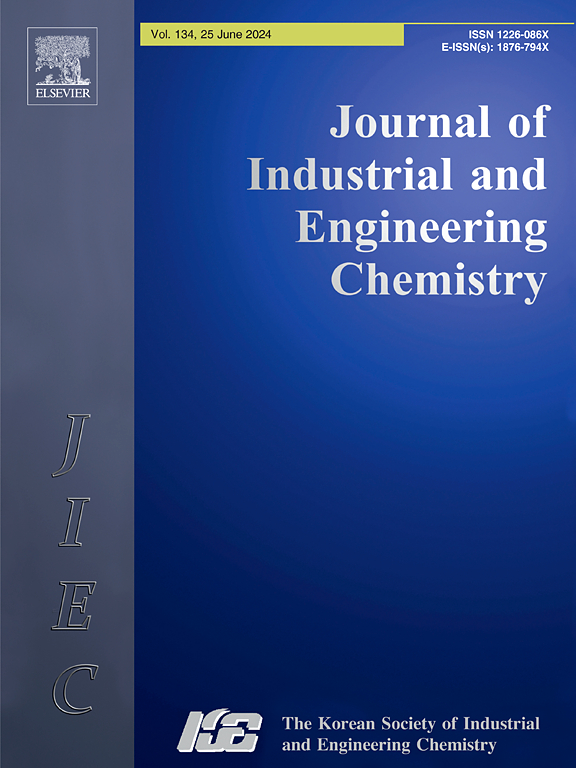在石墨烯碳空心球上生长纳米多孔共价有机框架;设计先进的多功能纳米复合材料
IF 5.9
3区 工程技术
Q1 CHEMISTRY, MULTIDISCIPLINARY
Journal of Industrial and Engineering Chemistry
Pub Date : 2025-01-25
DOI:10.1016/j.jiec.2024.06.045
引用次数: 0
摘要
首次在碳空心球(CHSs)石墨壳上原位合成了基于三聚氰胺的共价有机骨架(COFs),获得了具有独特热-机械特性的杂化纳米材料。为了提高CHS-COF纳米结构(NSs)的热稳定性,在其孔隙和内部空间中加载Zn2+/ l -谷氨酸钠(ZG)无机-有机配合物(表示为ZG@CHS-COF)。制备的环氧纳米复合材料表现出增强的热机械性能和紫外线屏蔽性能。与空白环氧树脂相比,填充CHS-COF和ZG@CHS-COF NSs的环氧涂料的抗拉强度分别提高了185%和168%。DMTA结果表明,填充CHS-COF和ZG@CHS-COF NSs的环氧树脂的玻璃化转变温度(Tg)分别升高了2.1℃和8.1℃左右。此外,CHS-COF和ZG@CHS-COF NSs存在时,tan(δ)峰(HTP)的高度较低,说明它们与环氧链的相互作用更好。在ZG@CHS-COF NSs的存在下,获得了最高的灰分含量(≈46.3%)和优异的热耐久性。TEM结果证实ZG@CHS-COF NSs的分散和分布优于CHS。在3周的紫外线照射后,ZG@CHS-COF-filled环氧涂层导致颜色变化减少71% (ΔE)。本文章由计算机程序翻译,如有差异,请以英文原文为准。
Growth of nano-porous covalent organic frameworks on graphenic carbon hollow spheres; towards designing advanced multi-functional nanocomposites
For the first time, melamine-based covalent organic frameworks (COFs) were synthesized in situ on the graphenic shells of carbon hollow spheres (CHSs) for achieving a hybrid nanomaterial with unique thermo-mechanical characteristics. To improve the thermal stability of CHS-COF nanostructures (NSs), Zn2+/sodium L-glutamate (ZG) inorganic-organic complexes were loaded in their porosities and interior spaces (denoted as ZG@CHS-COF). The fabricated epoxy nanocomposites illustrated enhanced thermo-mechanical and UV-shielding properties. The tensile strength of the epoxy coatings, filled with CHS-COF and ZG@CHS-COF NSs, increased by 185 and 168 %, respectively, compared to the blank epoxy. DMTA results revealed that the glass transition temperature (Tg) of the epoxy, filled with CHS-COF and ZG@CHS-COF NSs increased around 2.1 and 8.1 °C, respectively. Also, the lower height of tan(δ) peaks (HTP) in the presence of CHS-COF and ZG@CHS-COF NSs illustrated their better interactions with epoxy chains. The highest ash content (≈46.3 %) and superior thermal durability were acquired in the presence of ZG@CHS-COF NSs. TEM results confirmed the better dispersion and distribution of ZG@CHS-COF NSs than CHS ones. The ZG@CHS-COF-filled epoxy coating led to a 71 % reduction in color changes (ΔE) after 3 weeks of UV irradiation.
求助全文
通过发布文献求助,成功后即可免费获取论文全文。
去求助
来源期刊
CiteScore
10.40
自引率
6.60%
发文量
639
审稿时长
29 days
期刊介绍:
Journal of Industrial and Engineering Chemistry is published monthly in English by the Korean Society of Industrial and Engineering Chemistry. JIEC brings together multidisciplinary interests in one journal and is to disseminate information on all aspects of research and development in industrial and engineering chemistry. Contributions in the form of research articles, short communications, notes and reviews are considered for publication. The editors welcome original contributions that have not been and are not to be published elsewhere. Instruction to authors and a manuscript submissions form are printed at the end of each issue. Bulk reprints of individual articles can be ordered. This publication is partially supported by Korea Research Foundation and the Korean Federation of Science and Technology Societies.

 求助内容:
求助内容: 应助结果提醒方式:
应助结果提醒方式:


